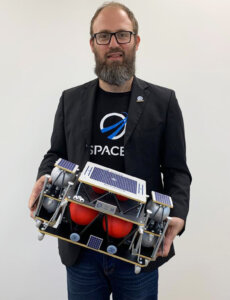Israel’s first spaceship crashed on the lunar surface. Its second just ran into a more Earthly obstacle.
SpaceIL’s rookie moonshot inspired a nation, and $90 million was a secured for a second attempt. But the sudden exit of a major benefactor has left the team scrambling

An Israeli child looks at a poster of Beresheet at the Planetaya Planetarium in the Israeli city of Netanya, on April 11, 2019, before it crashed during the landing. Photo by Jack Guez/AFP via Getty Images
Israel’s quest to become the fourth country to land a spaceship on the moon has suffered another setback, with its major funder cutting bait on the project.
It’s a somewhat less dramatic disappointment compared to the last for the privately funded mission. After an otherwise successful flight in 2019, the Israeli-built craft crashed into the lunar surface. Kfir Damari, the cyber security expert who helped mastermind the moonshot, had come so close that funders were willing to back the project again.
But this summer, his main backer dropped out. “It came as a surprise,” Damari told me, shaking his head.
Morris Kahn, an Israeli businessperson and philanthropist, had originally agreed to donate $90 million to the cause. He’d already given $45 million, but decided to back out midway through the project. “These times obligate us to invest our resources and time in other philanthropic projects,” Kahn said in a statement. Khan’s office did not respond to a request for further comment.
Damari’s quixotic quest has taken a toll. The 40-year-old’s face has thinned since the last time he was in the public eye, and his usual closely cropped beard, now streaked with gray, has grown to rabbinic proportions. But four years ago he captured Israel’s imagination and proved a bold, once-ridiculed plan could come tantalizingly close to success. There’s no way, he said, that he’s giving up now.
Chutzpah and spare parts
Damari’s spaceship, which now litters the lunar surface, was about the size of a dishwasher. He built it with two friends who figured out a way to send it, uncrewed, to the moon. The Israeli entrepreneurs (one owned a company that delivered hamburgers to players on a golf course via drones) were making an audacious attempt to become the fourth country after China, Russia, and the United States to land on the moon — and the first privately funded ship to do so.
While NASA and the European Space Agency rely on national budgets, Damari’s ship — christened the Beresheet, Hebrew for Genesis — would make it to the moon on a shoestring budget scraped together from individual investors.
They launched a startup called SpaceIL and raised the money from some of the usual suspects in the Jewish philanthropic world: Miriam and Sheldon Adelson, Charles and Lynn Schusterman, Sylvan Adams and Morris Kahn, among others.
Such a mission would normally cost upwards of $1 billion. Damari and his team, with a seemingly bottomless supply of chutzpah, devised a way to do it for $100 million.
They cut many corners: buying off-the-shelf parts and, most notably, hitching a ride on one of Elon Musk’s SpaceX rockets that was headed in the opposite direction. The lunar carpool ride on February 22, 2019, dropped the Beresheet off at a less-than-ideal spot in space for the mission, but it got them out of Earth’s atmosphere. And while a direct flight from the Earth to the moon would take a day, two max, the Beresheet, with so little power attached to it that it could only blink to life for brief moments at a time, would take six weeks to get near the moon.
Cable news channels broke into coverage to air the final descent of its journey, as the ship prepared for landing on April 11, 2019. Damari and dozens of engineers huddled around the monitors at the command center outside of Tel Aviv. Israeli Prime Minister Benjamin Netanyahu showed up to congratulate them. Millions watched, hoping to witness another moment as historic as the lunar landing, exactly 50 years earlier, of Buzz Aldrin and Neil Armstrong.
It was around midnight in Israel, but few were sleeping, as watch parties were held across the nation. Israeli President Reuven Rivlin invited hundreds of children for a late-night gathering at his residence.
Thirteen miles above the lunar surface, the Beresheet stretched out its metal arm and took a selfie with the moon in the background and sent it back to Earth. It would be its final act. The ship started speeding up instead of slowing down. Seconds later, it crashed into the surface of the moon.
“We did land,” Damari told me, managing a slight smile.

Second chances
Despite the last-second crash, many in Israel still saw the mission as a success.
Nine-year-old Ori Solow, who dressed up in a homemade Beresheet costume made out of cardboard and duct tape for Purim, had stayed up late into the night to watch the moon landing. I spoke with his mom, Atara, shortly after the crash. “It’s particularly meaningful for me to encourage him to dare, think creatively, innovate, and seek to make an impact,” she said. “Who knows? Maybe one day he will be developing the next space technology.”
She said the fact that the ship didn’t make it all the way was perhaps more meaningful. “What a strong lesson for our children. There’s no need for disappointment. We will get there eventually. It’s just a great and important accomplishment that hasn’t yet been completed.”
The Beresheet journey had inspired many, including the National Geographic channel, which made a documentary, Rookie Moonshot, about the mission. Within days, SpaceIL announced plans for a Beresheet 2 ship.
Morris Kahn and a group of investors agreed to foot most of the bill.
That was then, this is now.
An uncertain future

Damari has spent the past several years reliving the final moments of the Beresheet, figuring out what went wrong and what he could do to improve its chances of a successful landing.
For starters, the new ship looks much different, and bigger than a dishwasher. It’s got three parts: a mother ship that will carry two landers — one that it will drop off on the side facing Earth, and one for the far side of the moon.
And SpaceIL has more scientific partners now, with plans for each component to conduct scientific experiments. NASA signed a cooperation agreement with the company in January to study radiation on the surface of the moon. Several Australian universities want to use the landers to test growing plants on the moon — a critical endeavor if humans are to inhabit outer space. They have also developed a STEM educational curriculum where students on Earth can participate in the experiments in real time.
Damari’s crew was in the middle of manufacturing the various parts of the ship when, in late May, they got the bad news from Kahn’s office. The launch was scheduled for the start of 2026, but now, Damari said, they have just a few months left before the money runs out.
“Now we’re working to find someone in Israel or abroad that will want to join in and help us make it happen,” he said.
When I asked him why a donor should spend money on a spaceship instead of something on terra firma, he was quick to respond. He wants to inspire people, and a moon landing is a means to that end.
“Space is only something that helps us to create that inspiration,” he said.

















